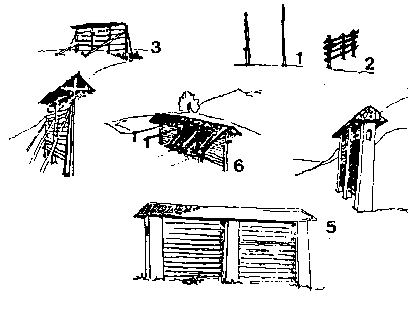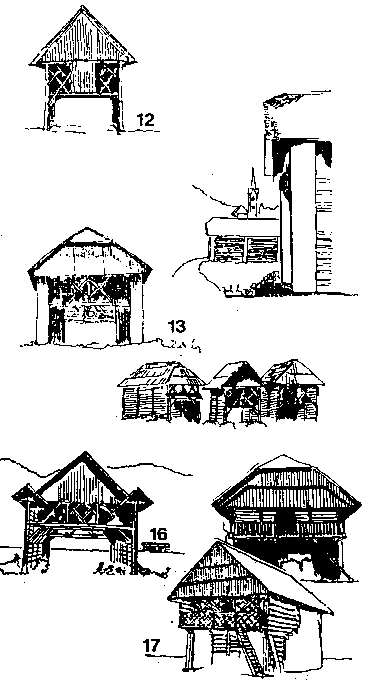

 A temporary drying device similar to the kozolec is a system
of vertical poles linked by horizontal bars (2).
It is the structure from which today's hayrack has developed,
but the fodder is still very exposed; it still lacks a roof.
A temporary drying device similar to the kozolec is a system
of vertical poles linked by horizontal bars (2).
It is the structure from which today's hayrack has developed,
but the fodder is still very exposed; it still lacks a roof.
The next stage in the evolution of hayracks is uniformity of manufacture, with a temporary or provisional roof (today mostly) covered with bark or sheet metal (3). Having already all the characteristic elements of a real hayrack, it would be regarded as one but for its provisional character.
The single stretched hayrack is the same device, only it is more sturdy. Its parts are held together by means of wood joints, it has a more resistant roof, and it is bigger and more functional than earlier structures. Because it is built in a windy spot, it is usually strengthened by supporting poles. The poles are attached to the back of the side facing the wind (6).
The posts (vertical supports) (13). Here, the roof is sometimes heavier and usually covered with stone. Often, there are ornaments at the ends of the roof.
A special variant of the hayrack is a "goat" or a "dog" hayrack with a "birtah" (apron) or cloak.
A double stretched hayrack consists of two single stretched hayracks linked together to form one structure. It is actually an intermediate stage in the development towards a low hayrack, which is a response to less favorable economic conditions. The low hayrack is of course very simple and hardly ever decorated.
 There are two types of double linked hayracks: one can be found
to the north of the Sava river (12), and the other to the south
of it (17). They differ only in the heaviness and solidity
of their fronts; all other elements are identical. The double linked
hayrack consists of the posts connected by horizontal bars, and a roof.
Transversal stability is ensured by a brana (a framework consisting
of one or two timber poles or "trees", with lattice work on either side;
that forms the front of the hayrack), while the longitudinal stability
is provided by a two or threedimensional nucleus.
There are two types of double linked hayracks: one can be found
to the north of the Sava river (12), and the other to the south
of it (17). They differ only in the heaviness and solidity
of their fronts; all other elements are identical. The double linked
hayrack consists of the posts connected by horizontal bars, and a roof.
Transversal stability is ensured by a brana (a framework consisting
of one or two timber poles or "trees", with lattice work on either side;
that forms the front of the hayrack), while the longitudinal stability
is provided by a two or threedimensional nucleus.
They are called "with one tree" and "with two trees" hayracks respectively. The latter variant is, of course, superior for there is more protected space inside.
There are different types of roofs, too: some are pitched, with open or closed gables (panelled with boards); some terminate in hipped gable ends (usually with the front enclosed), while others are hipped roofs. This last seems to be the oldest variant of all. In Bohinj, where it often rains, the hayracks acquire additional projecting roofs to protect exposed elements.
In places, a single stretched hayrack, a "tail", can be seen attached to a double one (16). Sometimes two "tails" can be attached; they, too, may be linked together.
(17). The loading platform may be fenced, with, possibly,
an opening, or simply left without side protection. Stairs or a ladder
are usually a constituent part of a hayrack. The front is usually closed
in with a dense brana or with boards. Newer hayracks are generally more
decorated, but only on the panelling, not in the construction as they are
in Stajerska.